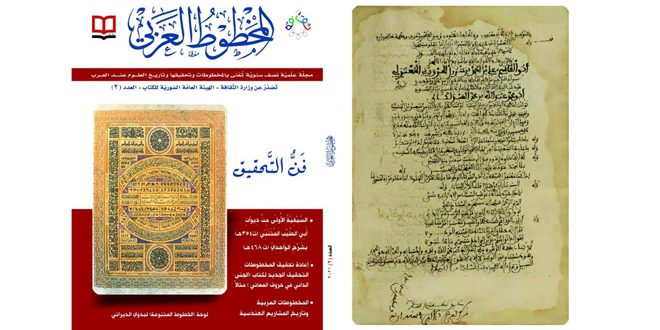The semi – annual Arabic Manuscript Magazine highlighted in its second issue the art of producing documents, the challenges that hinder the cataloger of manuscripts, the ways to solve them, and the many subjects associated with manuscript science.
The second issue of the magazine, issued by the Ministry of Culture and the Syrian General Book Organization, contained various titles and topics, including the journey of Arabic writing between Himyarite and Syriac by Muhammad Adnan al-Jawherji, while Dr. Bouthaina Jalkhi wrote about rubies in the Arab scientific heritage. Dr. Abbas Merhej Faraj wrote on the history of Ibn Khaldoun and Dr. Abdel Nasser Ismail Assaf wrote an article entitled “Re-investigation of manuscripts”.
The Ministry of Culture pointed out in an article published in the magazine on the art of investigation that manuscripts of all kinds are investigated in accordance with a well-known methodology to be followed. The first step is to compare the version to be achieved with others, to match the titles, dates and information, and not to rely on the reliability of the received information unless it is compatible with the time when it appeared, and with the approach, logic and thought of the author. The text should be maintained without addition or deletion, and without correction or improvement.
Regarding the 28,000 oriental manuscripts in the Russian National Library, Dr. Thaer Zain al-Din’s article, reveals an impressive collection of these manuscripts in the Russian National Library in Saint Petersburg, which was founded in 1795 AD, the date of the development of handwriting in the East. He indicated that many of them are rare in content and unique in genre and represent works that were not known before, as well as diverse subjects in literature, history, science of language, philosophy, religion, etc.
It is worth noting that the Arabic Manuscript is a semi-annual scientific magazine concerned with manuscripts, their realization, and the history of science among Arabs, with the aim of meeting the needs of readers and those interested in the texts of Arab heritage and revealing its treasures hidden in the world’s libraries.
Amal Farhat

